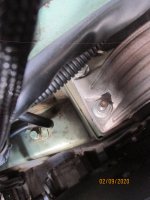Afternoon.
I bought a suitable clamp meter and am now at the vehicle with the apprentice

With me under the vehicle with meter in hand and on the right setting (to measure DC current), with clamp around the thin red wire connected to the starter motor, wifey turns key and I get a reading of
27.82V but engine doesn't crank.
We repeated this about 5 times over a period of 10 mins.
Without doing anything, the next key turn fired it up immediately.
When it wouldn't start, whilst trying to watch the reading on the meter, the click I could hear is much higher up in the engine bay and I would guess at saying from the fuse box.
Welcome your thoughts again guys. Thanks
If we substitute a value of 27.82A for the above reading, then it is entirely plausible.
At that current level, I would have expected the solenoid to engage the starter pinion and close its contact to energise the motor.
Presumably your head would be quite close to the starter assembly, And clunk from the solenoid should have been very noticeable.
My thoughts are that either 27.8A is insufficient, or something is physically preventing the starter pinion from engaging.
You have mentioned a click from higher in the engine bay, possibly in the fusebox. This is possible as it could be the main injection relay operating, which it must do for the engine to start.
Your apprentice may not have waited for the dash lights other than battery and oil to go out, before turning to the start position. It is good practice to wait for the lights to extinguish.. The click should then be audible before power is applied to the starter solenoid.
I am wondering whether it is time for the mechanic's pliers test, or perhaps a variation.
With battery negative disconnected, securely attach a length of perhaps 2.5mm insulated wire to the small starter solenoid terminal. Expose a very short length of the conductor at the remote end of the wire.
Remove cover from engine bay fusbox to expose the M6 input connection. Restore battery negative.
Ensure neutral selected, and handbrake on.
With ignition off, dab exposed wire end onto fusebox feed cable lug. Starter should operate reliably, and no need to start the engine. This is probably easier than lying underneath for several attempts, and does not drag apprentice away from domestic duties.
If starter operates reliably, then perhaps there is a problem in the engine bay fusebox. Other faults have occured in similar fuse boxes. For info
see here.

